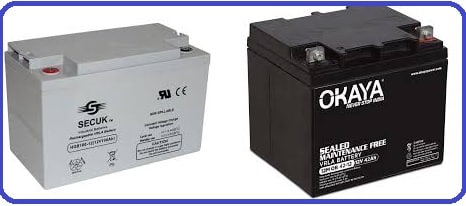A VRLA battery or Valve Regulated Lead Acid Battery is a sealed battery or maintenance-free battery. This is one type of Lead-acid rechargeable battery. The VRLA Battery does not require stringent ventilation. Also, we can mount the battery in any orientation. The reduced ventilation requirement is an added advantage of VRLA. The VRLA battery occupies less mounting space and moderate room ventilation. The VRLA battery is the most popular reserve power design because;
- The electrolyte is captive, preventing it from spilling even when its case is punctured.
- VRLA batteries are “maintenance free” and it does not require additional electrolyte or water.
Problems of flooded lead-acid battery
When the lead-acid battery charging is near completion, hydrogen (H2) gas liberates at the negative plate. Similarly, at the end of battery charging oxygen (O2) gas liberates at the positive plate. Hydrogen gas is released before mixing with water inside the battery. It happens because the reverse process of battery discharging to charging is not perfect.
To prevent the build-up of the explosive hydrogen gas, a battery has a vent to release the pressure. The electrolyte may spill out from the vents with tilting of the battery. This is a hazard during the shipping of the batteries and makes the battery unsuitable for many applications. Also, proper ventilation is required in the room.
Furthermore, the constant loss of Hydrogen leads to a reduction of water in the electrolyte. And, the battery needs lost water replenishment by opening the battery vent plug and topping up DM water.
Why VRLA Battery is better than flooded lead Acid Battery?
The valve-regulated lead-acid batteries hinder the movement of the electrolyte inside the battery container. And it traps the hydrogen gas near the plates. Thus, this process makes readily available hydrogen gas for re-combination during battery charging.

This type of construction greatly reduces water loss during the charging and discharging cycle. Thus, this technology makes the battery sealed and maintenance-free (no need to add water). This is the reason why we can use VRLA batteries in any position or orientation. There is no possibility of electrolyte spillage in VRLA. also, no water needs to add to the electrolyte in VRLA sealed maintenance-free batteries.
We use VRLA batteries for those applications which require a large amount of storage at a lower cost. We use VRLA batteries in a large portable electrical device, off-grid power systems, and similar roles.
How does Valve regulation function in VRLA Battery?
During rapid recharging, the electrolyte may boil and pressurize the battery case. The gas build-up may be too rapid for recombination to mix with oxygen to form water. These effects require “valve regulation”. This is normally in the form of a one-way pop-off valve. The valve opens in the case of pressure build-up.
The immobilizing agent prevents acid leakage when the valve pops. VRLA battery has a pressure relief valve that activates when the battery starts building pressure of Hydrogen gas. This is generally a result of being recharged at excessive voltage, typically greater than 2.30 volts per cell.
Valve activation allows some of the gas or electrolyte to escape. As a result, the overall capacity of the battery decrease. Therefore, the charging current of the VRLA battery shall not exceed the specified value recommended by the manufacturer.
Protection in VRLA Battery
- The electrolyte may produce too much pressure
- The hydrogen gas build-up may be too fast for recombination with the water
To regulate these events, a one-way pop-off valve is incorporated into the battery body which only opens when the pressure builds up. The immobilizer used in these batteries ensures that there would be no spillage or leakage of the liquid inside.
Related Posts